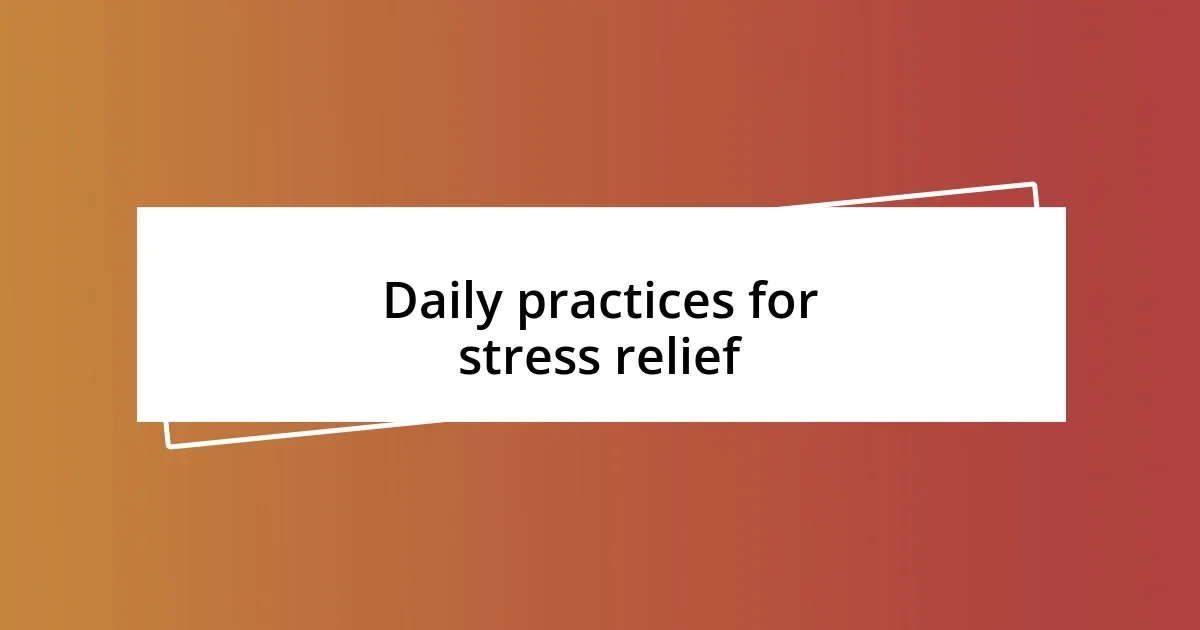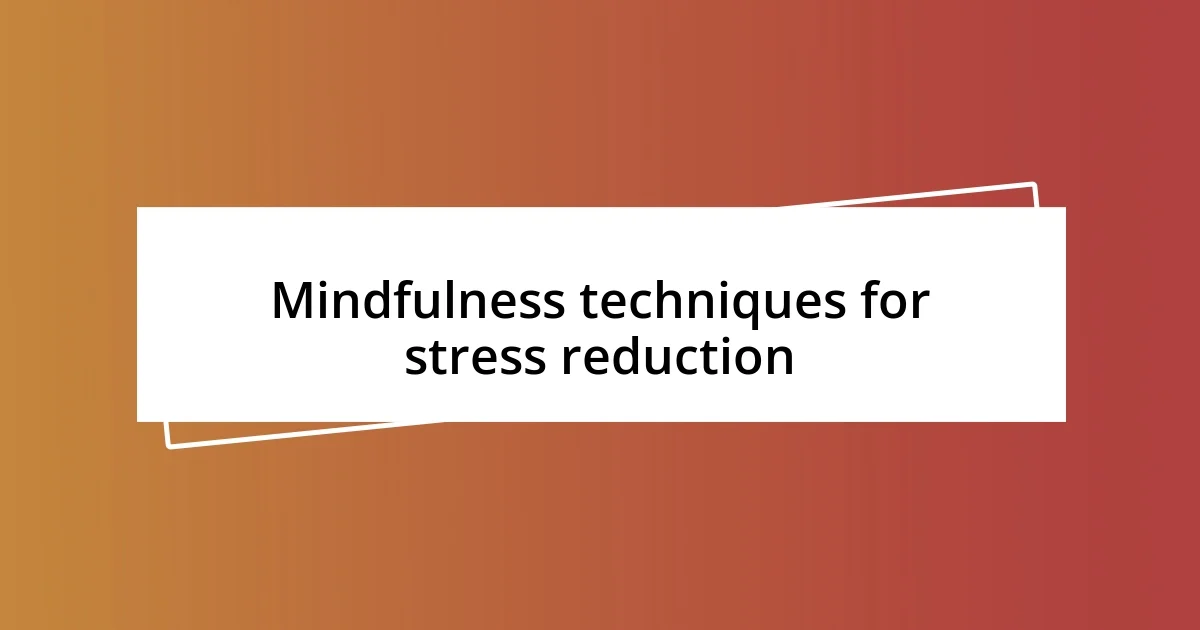Key takeaways:
- Personalized stress management strategies, such as journaling and mindfulness practices, are essential as each individual’s response to stress varies.
- Identifying stress triggers through journaling, mindfulness meditation, and open conversations enhances self-awareness and coping effectiveness.
- Building a support network and regularly evaluating stress relief techniques can lead to better mental health and improved stress management outcomes.

Understanding stress management strategies
Understanding stress management strategies involves recognizing that every individual’s response to stress is unique. I remember a time when I felt overwhelmed by multiple deadlines, and I tested various tactics to see what truly resonated with me. Different approaches, from deep breathing techniques to nature walks, made me realize that stress management isn’t one-size-fits-all; it’s about finding what genuinely soothes your spirit.
One strategy that really worked for me was journaling my thoughts. I often found that simply writing down my worries helped to externalize them, making them feel less daunting. This reflective practice not only gave me clarity but also served as a release. Have you ever tried putting your thoughts on paper? It can be incredibly freeing, almost like releasing a balloon into the sky, watching as it floats away from you.
Additionally, I’ve discovered that physical activity plays a crucial role in stress management. I used to underestimate the power of a brisk walk—just 30 minutes outdoors can shift my mindset dramatically. The fresh air and rhythmic movement seem to wash away stress, making space for clearer thoughts and a sense of calm. Have you ever noticed how a little movement can brighten your mood? It’s fascinating how our bodies respond to simple changes.

Identifying my stress triggers
Identifying my stress triggers has been an enlightening journey. I often find that certain situations or interactions can push me toward anxiety without me even realizing it. For instance, I used to feel a wave of stress wash over me whenever I was in large group settings, particularly when I had to speak up. Reflecting on those moments, I learned to pinpoint that discomfort and understand that my apprehension stemmed from a fear of being judged.
To help clarify my triggers, I’ve employed a few practical strategies:
- Keeping a Trigger Journal: I note situations that contribute to my stress, allowing me to spot patterns over time.
- Mindfulness Meditation: This practice helps me stay present, making it easier to recognize when stress begins to creep in.
- Talking It Out: Open conversations with friends and family have often revealed shared experiences, helping me to see that I’m not alone.
- Physical Sensations: I pay attention to my body’s responses—tightness in my chest or tension in my shoulders often signal rising stress levels.
This thoughtful approach has helped me gain awareness of my stress triggers, empowering me to navigate them more effectively.

Daily practices for stress relief
Daily practices for stress relief can be a game changer in how we handle life’s challenges. One of my go-to methods is starting the day with mindfulness meditation. I find that taking just five minutes each morning to focus on my breath creates a sense of calm that follows me throughout the day. Have you ever noticed how a few intentional breaths can ground you, even when chaos surrounds you? That mindfulness sets a positive tone for whatever lies ahead.
In addition to meditation, I’ve incorporated gratitude journaling into my routine. I usually jot down three things I’m thankful for each evening. It’s surprising how shifting my focus to the positives can lighten the weight of daily stressors. On tough days, this practice serves as a gentle reminder that there’s always something good to hold onto. Would you believe that a simple act of gratitude could transform your perspective?
I also make it a point to limit my screen time, especially before bed. I’ve experienced firsthand how scrolling through social media can lead to unnecessary stress and comparison. Instead, I engage in reading a book or practicing light yoga. This not only calms my mind but also promotes better sleep. Have you considered how your evening habits might be influencing your mental well-being? Finding that balance can truly help in unwinding from the day.
| Practice | Description |
|---|---|
| Mindfulness Meditation | Focus on your breath for a few minutes to create calm. |
| Gratitude Journaling | Log three positive things each day to shift focus from stress. |
| Limiting Screen Time | Reduce social media exposure to lower stress before bed. |

Mindfulness techniques for stress reduction
One mindfulness technique that I’ve found incredibly effective for stress reduction is the practice of body scanning. Each evening, I take a few moments to close my eyes and mentally focus on each part of my body, starting from my toes and working my way up to my head. Have you ever noticed how much tension you might be holding in places you didn’t even realize? This practice allows me to consciously relax those muscles and brings a wave of calmness. I can almost feel the stress melting away as I acknowledge and release that tension.
Another approach I treasure is mindful walking. I often take my walks in nature, paying attention to the sounds, sights, and smells around me. While walking, I remind myself to breathe deeply and really experience the moment. It’s amazing how a simple stroll transformed into a mindfulness exercise can elevate my mood. I’ve found that when I attune myself to the world around me, the worries that seemed so heavy start to dissipate. Have you tried stepping outside for a few moments of peace? You might be pleasantly surprised by how it can shift your perspective.
Lastly, I often practice mindful eating, which has become an eye-opening experience for me. Rather than scarfing down my meals in a hurry, I take the time to truly savor each bite. By paying attention to flavors and textures, I not only find joy in my food but also create moments of calm in what can often be a chaotic part of my day. It’s fascinating to think how something as simple as eating can be transformed into a mindful practice. How often do we rush through meals without really tasting them? This shift has made every meal a chance to relax and connect with my senses.

Physical activities that reduce stress
Engaging in physical activities has been a vital tool in my stress management toolkit. Whenever I feel overwhelmed, I lace up my sneakers and go for a run. There’s something liberating about feeling the wind on my face and the rhythm of my heartbeat. Have you ever noticed how running can almost flush out negative energy, leaving you invigorated? I always return home with a clearer mind and a lighter heart.
Yoga has also become a cherished practice for me. Each session feels like a mini-retreat, where I can momentarily detach from life’s demands. The combination of stretching and deep breathing allows me to reconnect with my body and release pent-up tension. I vividly remember a particular class where I held a pose longer than usual, and I could literally feel stress melting off me, step by step. Have you ever found yourself in a position where you thought, “I never knew I needed this?” That’s the beauty of yoga—it offers those unexpected moments of relief.
I can’t overlook the impact of dancing. Whether it’s a full-on salsa session or just grooving in my living room, it’s a guaranteed mood booster. Last weekend, I cranked up my favorite playlist and danced like nobody was watching. It was like therapy without the cost! The joy of letting loose and moving freely often transforms my stress into pure exhilaration. Have you ever experienced that rush of happiness when just letting your body move to the music? It’s incredible how physical activity can instantly lift your spirits and provide a much-needed release.

Building a support network
Building a support network is one of the cornerstones of managing stress effectively. I still remember when I faced a particularly tough week; I reached out to a close friend who ended up being my unexpected lifeline. Just sharing my concerns over coffee helped me gain perspective, reminding me that I wasn’t alone in my struggles. Have you tried confiding in someone when you’re feeling overwhelmed? Sometimes, it’s the simple act of talking that can lighten a heavy heart.
Not all support needs to come from family or lifelong friends. I’ve found that engaging in community groups, whether they’re focused on a shared hobby or mutual interests, can create a sense of belonging. I joined a local book club a while ago, and the connections I made there brought both joy and comfort during stressful times. It’s fascinating how quickly an impromptu discussion about a novel can evolve into heartfelt conversations about life challenges. Have you considered exploring new social circles? You might find that like-minded individuals can offer fresh perspectives that resonate with your experience.
Additionally, technology offers us an incredible platform to connect. I often turn to online support groups when I need encouragement or shared experiences. For instance, I recently joined a forum for stress management, where individuals openly share tools they’ve found helpful. Reading their stories truly uplifted me, making me feel part of a larger community. Have you ever felt that surge of inspiration from hearing someone else’s story? It’s a reminder that we’re all navigating this complex world together, and sometimes a few supportive words can make all the difference.

Evaluating and adjusting my approach
Evaluating my stress management techniques is essential for me to stay effective and grounded. I often set aside time each month to reflect on what’s working and what isn’t. For instance, I once realized that my initial enthusiasm for meditation waned as life got busier. I had to ask myself, “Am I really prioritizing my peace of mind?” Sometimes, it’s those moments of honesty that lead to significant breakthroughs.
As I make adjustments, I pay close attention to how different strategies resonate with me. One day, after a particularly stressful encounter at work, I opted for a long walk instead of jumping straight into my usual evening routines. The fresh air and time to think provided clarity I didn’t anticipate. Have you ever found that a simple change in your environment can shift your mindset entirely? That experience made me realize I need to remain flexible in my approach, sometimes benefiting from the unexpected.
Recently, I also started to track my mood alongside my stress management practices. I keep a journal where I note how I feel after trying new techniques, whether it’s a short breathing exercise or cooking a favorite meal. Reflecting on those entries helps me spot patterns and adjust my strategies accordingly. It’s intriguing—what did I enjoy more, a scenic hike or a quiet evening with a book? This personal feedback loop adds a layer of accountability. Have you thought about documenting your own experiences? It could be the key to discovering your most effective stress relief methods.














